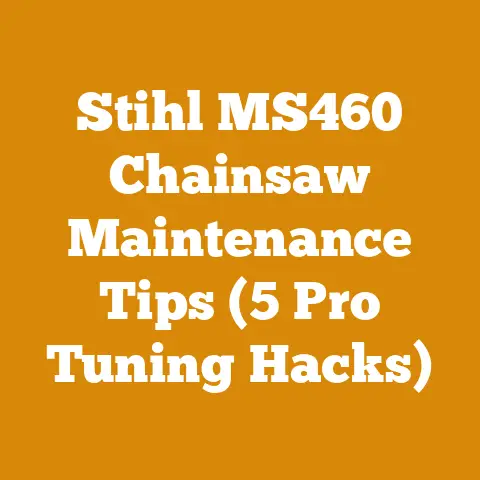Clean Stihl Chainsaw Air Filter Tips (Pro Woodcutting Hacks)
If your Stihl chainsaw is coughing and sputtering, a dirty air filter is often the first culprit. A clean air filter is crucial for optimal performance and longevity of your Stihl chainsaw. I can show you some pro woodcutting hacks to keep that filter clean and your saw humming.
Cleaning Stihl Chainsaw Air Filter: Pro Woodcutting Hacks
Maintaining your Stihl chainsaw’s air filter isn’t just about keeping your saw running; it’s about ensuring its longevity and performance. Over the years, I’ve seen countless saws sidelined due to neglected air filters. I’ve learned some tricks and techniques that can significantly extend the life of your filter and improve your chainsaw’s efficiency. Let’s dive into the nitty-gritty of cleaning your Stihl chainsaw air filter like a pro.
Why a Clean Air Filter Matters
A clean air filter is the unsung hero of your chainsaw. It performs several vital functions that directly impact your saw’s performance and lifespan.
- Optimal Airflow: A clean filter allows the right amount of air to reach the engine. This is essential for proper combustion.
- Engine Protection: It prevents dust, debris, and wood particles from entering the engine, which can cause significant wear and tear.
- Fuel Efficiency: With proper airflow, your chainsaw will burn fuel more efficiently, saving you money and reducing emissions.
- Consistent Performance: A clean filter ensures your saw runs smoothly without bogging down or stalling, especially during demanding cuts.
I remember one instance where a fellow logger was convinced his saw was on its last legs. It was constantly stalling and lacked power. After a quick inspection, I found the air filter completely clogged with sawdust. A simple cleaning restored the saw to its former glory, saving him the expense of a new machine. This highlights just how crucial a clean air filter is for maintaining your chainsaw’s performance.
Understanding Stihl Air Filter Types
Stihl chainsaws come equipped with various types of air filters, each designed to handle different levels of dust and debris. Knowing which type you have is the first step in proper maintenance.
- Standard Felt Filters: These are common in older or entry-level models. They’re effective for general use but require frequent cleaning.
- HD2 Filters: These are high-performance filters made from polyethylene (PET) fleece. They offer superior filtration and are more durable than felt filters.
- HD Filters: These are similar to HD2 filters but may have slight variations in material or construction.
- Nylon Mesh Filters: These are often used as pre-filters in conjunction with other filter types. They catch larger particles and extend the life of the main filter.
Identifying your filter type is usually straightforward. Check your chainsaw’s manual or look for markings on the filter itself. Knowing the type will guide you in choosing the appropriate cleaning method.
Tools and Materials You’ll Need
Before you start cleaning, gather all the necessary tools and materials. Having everything at hand will make the process smoother and more efficient.
- Soft Brush: A small, soft-bristled brush is ideal for removing loose debris without damaging the filter material. An old toothbrush works well.
- Compressed Air: A can of compressed air or an air compressor with an adjustable nozzle is essential for blowing out stubborn particles.
- Mild Soap and Water: For washing the filter, use a mild detergent diluted in water. Avoid harsh chemicals that can degrade the filter material.
- Clean Rags: Use clean, lint-free rags to dry the filter after washing.
- Safety Glasses: Protect your eyes from flying debris when using compressed air.
- Gloves: Optional, but recommended to keep your hands clean.
- Screwdriver or Wrench: Depending on your Stihl model, you may need a screwdriver or wrench to access the air filter housing.
I always keep a dedicated set of these tools in my workshop, specifically for chainsaw maintenance. It saves time and ensures I have the right tools for the job.
Step-by-Step Guide to Cleaning Your Stihl Air Filter
Now, let’s get down to the actual cleaning process. Follow these steps to ensure a thorough and effective cleaning of your Stihl chainsaw air filter.
Step 1: Accessing the Air Filter
The first step is to locate and access the air filter housing on your Stihl chainsaw. The location varies depending on the model, but it’s usually near the engine, under a cover secured by screws or clips.
- Turn off the Chainsaw: Ensure the chainsaw is turned off and the engine is cool before starting any maintenance.
- Locate the Air Filter Housing: Consult your chainsaw’s manual if you’re unsure of the location.
- Remove the Cover: Use a screwdriver or wrench to remove the cover, taking care not to strip any screws.
- Remove the Air Filter: Gently remove the air filter from the housing. Note its orientation for proper reinstallation.
When removing the filter, I always pay attention to how it fits in the housing. This helps ensure I reinstall it correctly later, which is crucial for proper sealing and filtration.
Step 2: Dry Cleaning the Air Filter
Before washing the filter, it’s essential to remove as much loose debris as possible using dry cleaning methods.
- Tap the Filter: Gently tap the filter against a clean, hard surface to dislodge loose particles.
- Brush the Filter: Use a soft brush to gently brush away any remaining debris. Brush from the inside out to avoid pushing particles deeper into the filter material.
- Use Compressed Air: Hold the compressed air nozzle a few inches away from the filter and blow air through it, starting from the inside out. Use short bursts of air to avoid damaging the filter material.
I often use a combination of tapping, brushing, and compressed air to ensure I remove as much dry debris as possible before moving on to wet cleaning.
Step 3: Washing the Air Filter (If Necessary)
If the filter is heavily soiled or oily, washing it may be necessary. However, avoid washing felt filters unless absolutely necessary, as excessive washing can degrade the material.
- Prepare Soapy Water: Mix a small amount of mild detergent with warm water.
- Submerge the Filter: Gently submerge the filter in the soapy water and agitate it to loosen dirt and oil.
- Rinse Thoroughly: Rinse the filter under clean, running water until all traces of soap are gone.
- Inspect the Filter: Check the filter for any damage, such as tears or holes. Replace the filter if it’s damaged.
When washing, I avoid using hot water or harsh chemicals, as these can damage the filter material. Gentle agitation and thorough rinsing are key to a successful cleaning.
Step 4: Drying the Air Filter
Proper drying is crucial to prevent mold or mildew growth on the filter.
- Shake off Excess Water: Gently shake off any excess water from the filter.
- Blot with a Clean Rag: Use a clean, lint-free rag to blot the filter and remove as much moisture as possible.
- Air Dry: Allow the filter to air dry completely in a well-ventilated area. Avoid using a hairdryer or placing the filter in direct sunlight, as this can damage the material.
I usually let the filter air dry for at least 24 hours to ensure it’s completely dry before reinstalling it in the chainsaw.
Step 5: Oiling the Air Filter (If Applicable)
Some Stihl chainsaws, particularly those used in dusty environments, require the air filter to be lightly oiled. This helps trap fine particles and improve filtration.
- Use Air Filter Oil: Use a dedicated air filter oil specifically designed for foam or fleece filters. Avoid using motor oil or other substitutes.
- Apply Oil Sparingly: Apply a small amount of oil to the filter and distribute it evenly by squeezing and massaging the filter material.
- Remove Excess Oil: Use a clean rag to blot the filter and remove any excess oil. The filter should be lightly oiled, not saturated.
When oiling, I always err on the side of caution and use less oil rather than more. Too much oil can restrict airflow and cause the engine to run poorly.
Step 6: Reinstalling the Air Filter
Once the filter is clean, dry, and oiled (if applicable), it’s time to reinstall it in the chainsaw.
- Inspect the Filter Housing: Clean the air filter housing to remove any debris or dirt.
- Position the Filter: Align the filter with the housing, ensuring it’s properly seated and sealed.
- Reinstall the Cover: Replace the cover and secure it with screws or clips. Tighten the screws or clips snugly, but avoid over-tightening.
Before starting the chainsaw, I always double-check that the air filter is properly installed and the cover is securely fastened. This prevents unfiltered air from entering the engine and causing damage.
Pro Tips for Extending Air Filter Life
Cleaning your air filter regularly is essential, but there are also some pro tips that can help extend its life and improve its performance.
- Clean Regularly: Establish a regular cleaning schedule based on your usage. Clean the filter after every 10-20 hours of use, or more frequently if you’re working in dusty conditions.
- Use a Pre-Filter: If your chainsaw is equipped with a pre-filter, clean it regularly to reduce the amount of debris that reaches the main filter.
- Store Chainsaw Properly: Store your chainsaw in a clean, dry place to prevent dust and debris from accumulating on the air filter.
- Avoid Cutting in Dirty Conditions: Whenever possible, avoid cutting in excessively dusty or dirty conditions. If you must cut in these conditions, clean the air filter more frequently.
- Inspect Regularly: Regularly inspect the air filter for any signs of damage, such as tears or holes. Replace the filter if it’s damaged.
- Use Genuine Stihl Filters: When replacing your air filter, use genuine Stihl filters to ensure proper fit and performance.
I’ve found that following these tips can significantly extend the life of my air filters and keep my chainsaws running smoothly for longer.
Common Mistakes to Avoid
Cleaning a Stihl chainsaw air filter is a straightforward process, but there are some common mistakes to avoid.
- Using Harsh Chemicals: Avoid using harsh chemicals or solvents to clean the filter, as these can damage the filter material.
- Over-Oiling: Applying too much oil to the filter can restrict airflow and cause the engine to run poorly.
- Washing Felt Filters Excessively: Washing felt filters too often can degrade the material and reduce their effectiveness.
- Reinstalling a Damaged Filter: Reinstalling a damaged filter can allow unfiltered air to enter the engine and cause damage.
- Over-Tightening the Cover: Over-tightening the air filter cover can strip the screws or damage the housing.
- Forgetting to Clean the Housing: Neglecting to clean the air filter housing can allow debris to accumulate and contaminate the new or cleaned filter.
By avoiding these common mistakes, you can ensure that your air filter cleaning efforts are effective and don’t cause any damage to your chainsaw.
Troubleshooting Common Issues
Even with regular cleaning and maintenance, you may encounter some issues with your Stihl chainsaw air filter. Here are some common problems and how to troubleshoot them.
- Chainsaw Stalling or Bogging Down: This can be caused by a clogged air filter restricting airflow. Clean the filter and check for any other potential causes, such as a dirty spark plug or fuel filter.
- Reduced Power: A dirty air filter can reduce the amount of air reaching the engine, resulting in reduced power. Clean the filter and check for any other potential causes, such as a dull chain or improper fuel mixture.
- Excessive Fuel Consumption: A dirty air filter can cause the engine to run rich, resulting in excessive fuel consumption. Clean the filter and check for any other potential causes, such as a dirty carburetor or faulty fuel pump.
- Difficult Starting: A dirty air filter can make it difficult to start the chainsaw. Clean the filter and check for any other potential causes, such as a weak spark or low compression.
- Visible Damage to the Filter: If the air filter is torn, cracked, or otherwise damaged, replace it immediately to prevent unfiltered air from entering the engine.
I always keep a spare air filter on hand so I can quickly replace a damaged filter and get back to work.
When to Replace Your Air Filter
Even with regular cleaning, air filters eventually wear out and need to be replaced. Here are some signs that it’s time to replace your Stihl chainsaw air filter.
- Visible Damage: If the filter is torn, cracked, or otherwise damaged, replace it immediately.
- Excessive Dirt or Oil: If the filter is heavily soiled or oily and cannot be cleaned effectively, replace it.
- Reduced Performance: If you notice a significant reduction in chainsaw performance, even after cleaning the filter, it may be time to replace it.
- Age: As a general rule, replace your air filter every year, or more frequently if you use your chainsaw heavily.
I usually replace my air filters annually, regardless of their condition. This ensures that my chainsaws are always running at peak performance.
Alternative Cleaning Methods
While the methods I’ve described are the most common and effective, there are also some alternative cleaning methods you can try.
- Ultrasonic Cleaner: An ultrasonic cleaner can be used to remove stubborn dirt and oil from the filter. Follow the manufacturer’s instructions for using the cleaner.
- Dishwasher: Some people have had success cleaning air filters in the dishwasher. However, this method is not recommended, as it can damage the filter material. If you choose to try this method, use a gentle cycle and avoid using harsh detergents.
- Vinegar and Water: A mixture of vinegar and water can be used to clean the filter. Soak the filter in the mixture for a few minutes, then rinse thoroughly with clean water.
I personally prefer the traditional methods of cleaning with a brush, compressed air, and mild soap and water. However, these alternative methods may be worth trying if you’re having trouble removing stubborn dirt or oil.
The Importance of Proper Storage
Proper storage of your Stihl chainsaw is just as important as regular maintenance. Storing your chainsaw correctly can prevent dust, debris, and moisture from accumulating on the air filter and other components.
- Clean the Chainsaw Before Storing: Before storing your chainsaw, clean it thoroughly to remove any dirt, debris, or oil.
- Store in a Clean, Dry Place: Store your chainsaw in a clean, dry place, such as a garage or shed. Avoid storing it in damp or dusty environments.
- Use a Chainsaw Case: Use a chainsaw case to protect the chainsaw from dust, debris, and physical damage.
- Drain the Fuel Tank: If you’re storing the chainsaw for an extended period, drain the fuel tank to prevent the fuel from going stale and damaging the engine.
- Remove the Spark Plug: Remove the spark plug and pour a small amount of oil into the cylinder to prevent rust.
I always follow these storage tips to ensure that my chainsaws are in good condition and ready to use whenever I need them.
Safety Precautions
Working with chainsaws and cleaning their components can be dangerous if proper safety precautions are not followed. Here are some important safety tips to keep in mind.
- Wear Safety Glasses: Always wear safety glasses to protect your eyes from flying debris.
- Wear Gloves: Wear gloves to protect your hands from dirt, oil, and sharp edges.
- Work in a Well-Ventilated Area: Work in a well-ventilated area to avoid breathing in fumes from cleaning solvents or gasoline.
- Disconnect the Spark Plug: Disconnect the spark plug before performing any maintenance to prevent accidental starting.
- Follow Manufacturer’s Instructions: Always follow the manufacturer’s instructions for cleaning and maintaining your Stihl chainsaw.
- Use Caution with Compressed Air: Use caution when using compressed air to avoid blowing debris into your eyes or skin.
- Dispose of Waste Properly: Dispose of used cleaning solvents, rags, and air filters properly, following local regulations.
I always prioritize safety when working with chainsaws and their components. Taking the time to follow these safety precautions can prevent accidents and injuries.
Case Studies: Real-World Examples
To illustrate the importance of proper air filter maintenance, here are a few case studies from my own experiences and those of other loggers I know.
- Case Study 1: The Neglected Air Filter: A fellow logger neglected to clean his air filter for several months. His chainsaw started running poorly and eventually stalled completely. Upon inspection, the air filter was completely clogged with sawdust and oil. The engine had suffered significant damage and required expensive repairs.
- Case Study 2: The Proactive Maintenance: Another logger made it a habit to clean his air filter after every 10 hours of use. His chainsaw ran smoothly and efficiently for many years, with minimal maintenance issues.
- Case Study 3: The Oiled Air Filter: A logger working in a particularly dusty environment used an oiled air filter to improve filtration. His chainsaw’s engine remained clean and free of debris, even after extended use in harsh conditions.
These case studies demonstrate the direct impact of air filter maintenance on chainsaw performance and longevity.
The Environmental Impact
Proper chainsaw maintenance, including regular air filter cleaning, can also have a positive impact on the environment.
- Reduced Emissions: A clean air filter ensures that the engine runs efficiently, reducing emissions of harmful pollutants.
- Fuel Efficiency: A clean air filter improves fuel efficiency, reducing the amount of fuel consumed and the associated environmental impact.
- Extended Chainsaw Life: Regular maintenance extends the life of the chainsaw, reducing the need for replacement and the associated environmental impact of manufacturing and disposal.
- Proper Disposal of Waste: Proper disposal of used cleaning solvents, rags, and air filters prevents pollution and protects the environment.
I believe that it’s important for all loggers and chainsaw users to be mindful of the environmental impact of their activities and to take steps to minimize it.
Staying Updated with the Latest Technology
The world of chainsaws and woodcutting is constantly evolving, with new technologies and techniques emerging all the time. It’s important to stay updated with the latest advancements to ensure that you’re using the best practices for air filter maintenance and chainsaw operation.
- Read Industry Publications: Subscribe to industry publications and websites to stay informed about the latest technologies and techniques.
- Attend Workshops and Seminars: Attend workshops and seminars to learn from experts and network with other professionals.
- Follow Online Forums and Communities: Participate in online forums and communities to share knowledge and learn from others.
- Consult with Stihl Dealers: Consult with Stihl dealers to get advice on the latest products and maintenance techniques.
I make it a point to stay updated with the latest technologies and techniques in the woodcutting industry. This helps me improve my skills, increase my efficiency, and reduce my environmental impact.






